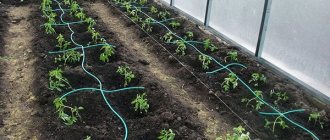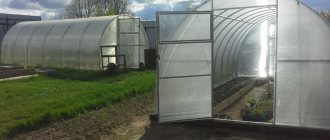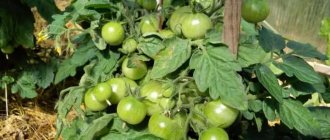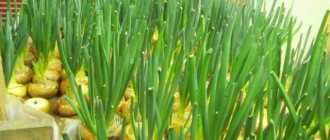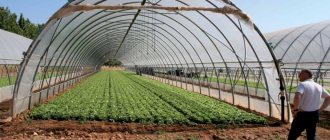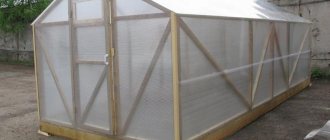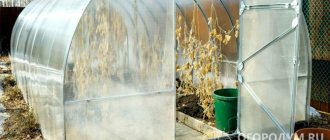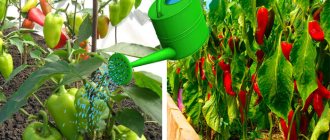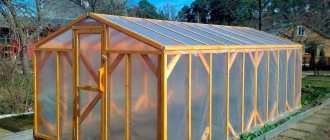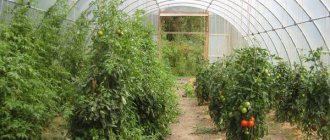A lot depends on the correct placement of tomato plants - productivity, ease of care, the presence of pests and diseases and, of course, the good mood of the gardener. When choosing the optimal planting scheme, take into account the biology of the tomato crop and the characteristics of a particular variety, its growth vigor and development characteristics. In this article I tell you in detail at what distance to make beds and rows in a greenhouse, plant standard, determinate and tall tomatoes, what are the disadvantages of thickened and too sparse plantings.
Planting schemes
When planting tomato seedlings in cultivation structures, a strip scheme is usually used. The parameters in this case are maintained based on the characteristics of the culture.
Table 1: Schemes for planting tomatoes in a greenhouse
| Varieties | Distance, cm | |
| between the tapes | between the rows | |
| short | 80-90 | 50 |
| tall | 90-100 | 60 |
When growing tomatoes on a shelf, the row method is used with a distance of 60 cm. The gap between plants is 40 cm.
The number of bushes for a greenhouse is 3 by 4 and 3 by 6
Knowing the size of the greenhouse and the distances in planting patterns, it is not difficult to make calculations for the number of seedling bushes. The beds are formed along the long side of the structure. In this case, the length of the rows will be 4 and 6 m.
With a greenhouse width of 3 m, the summer resident will be able to lay one tape in 2 rows in the center and 1 row along the side walls. A total of 4 rows are obtained.
Table 2: Average calculation results
| Varieties | Quantity per row, bushes | Total bushes | |
| 3x4 m | 3x6 m | ||
| undersized/standard | 10/14 | 14/20 | 40/56 and 56/80 |
| tall | 7 | 9 | 28 and 36 |
If you plan to plant bushes of different heights in one greenhouse, then it is better to allocate a central ribbon for tall ones, and side rows for short ones. If you place the plants in a checkerboard pattern, the bed can be compacted a little.
What influences placement
As a rule, gardeners plant several varieties of tomatoes in a greenhouse. However, some other criteria also influence the scheme:
- The direction of the wind affects temperature regulation and the presence of drafts in the room. Thus, tomatoes with poor resistance to temperature changes are best planted against the walls of the greenhouse.
- Lighting. There are varieties that need a lot of light. They must be placed on the sunny side.
- A combination of different varieties. In a small space, it is more profitable to plant tomatoes with a variety of characteristics. For example, you can combine light-loving varieties with shade-tolerant ones.
- The level of amenities is an important factor in choosing an accommodation option. This includes the location of greenhouse beds, the design of irrigation systems, lighting, heating and ventilation.
How to properly plant tomatoes in a greenhouse
Prepare the enclosed space in advance, assessing its sanitary condition and removing the remains of predecessor crops. The first step in the new season is preparing the soil. It is dug up to a depth of 25-30 cm. At the same time, compost (1.5-2 buckets/sq.m) and mineral water are added under the shovel:
- simple (or double) superphosphate – 100 (50) g;
- potassium chloride – 30 g;
- potassium magnesia – 50 g;
- sulfates: iron and copper – 5 g each.
If cucumbers were grown in these beds before planting tomatoes, then instead of compost when digging, crushed sphagnum peat or sawdust (a bucket per 1 sq.m.) is added to the soil. Nitrogen fertilizers are not used at this time.
Then plant tomatoes for next year. What to plant after tomatoes
Planting tomatoes
A day or two before planting the seedlings in the ground, the beds are thoroughly soaked with water to a depth of 10-15 cm. Under each bush, holes are formed on a flat surface according to the chosen pattern.
To ensure that the rows are even and the planting step is maintained, it is recommended to use a stretched cord and a marker.
Only well-developed healthy seedlings are selected for cultivation. It is lowered into the ground vertically, deepening along the cotyledons. Those tomatoes that will develop on the trellis are immediately tied to a pre-stretched twine. Having finished planting, the beds between the rows are loosened and leveled with a rake.
Growing seedlings and planting in greenhouse beds
The prepared containers are filled with soil substrate, compacting it. It is necessary to make grooves in the soil (1-1.5 cm deep). The ground is watered with warm sodium humate hydrate and the seed is distributed evenly. Sprinkle the soil mixture over the furrow. Planting containers are placed in a sunny place. The room temperature should be +22°C. The planting is covered with polyethylene or glass.
After 2 true leaves appear (7-10 days after sprouting), pick them into a large container. Using a toothpick, each sprout is removed along with a lump of earth and transferred to large containers. Seedlings are kept in boxes for no longer than 50 days.
The seedlings are transplanted into greenhouse conditions when 8-12 leaves and 1-2 inflorescences appear on the stem. 2-3 days before moving to the greenhouse, the bushes are prepared: 2-3 lower leaves are torn off, leaving rather long stumps (15 mm). The measure will reduce the crop’s exposure to disease and improve air circulation. The plantings will be evenly illuminated.
Tomato care
Growing tomatoes in greenhouses requires compliance with basic regimes. They will vary slightly depending on the time of year.
Table 3: Regimes for growing tomatoes in a greenhouse
| Mode | In heated winter | In spring | Summer-autumn turnover |
| Temperature* | The soil warms up to 18-20 degrees. The air temperature changes according to the development phase of tomatoes: - before flowering 22-24° on a sunny day and 18-20 on a cloudy day; at night 15-16°; - budding - the indicators increase by a couple of degrees; - fruiting - temperature rises another 2° | The same temperatures are maintained throughout the entire period: — on a sunny day 21-23°; — on cloudy days 18-20; — at night 15-16 | The regime changes depending on the month: — July-August: 24-26c (18-20p) during the day; 16-17 at night; — September-October: on a sunny day it is reduced by 4°, on a cloudy day by 1; at night by 2; — November: 18-20s (17-19p) during the day, 14-15 at night The temperature in the soil is maintained at 17-18° throughout the season. |
| Humidity | To ensure better pollination, a relatively dry climate is maintained in the greenhouse. | ||
| Watering** | Moderate, as the soil dries with water 20-25 degrees | Watering is rare but plentiful. The soil should be wetted to the entire depth of the fertile layer. Use warm water, not lower than 15° | In the summer months, they adhere to the spring regime. From September to November they gradually switch to winter |
| Feeding | Carried out in stages: - after rooting; - during the first ovaries; - during fruiting Use a mixture of urea, superphosphate, potassium sulfate | Tomatoes are fed 4-6 times per season, maintaining an interval of 2-3 weeks. The composition of fertilizers depends on the development phase: — at the beginning of the growing season, the ratio of potassium and nitrogen is 3:1 (or 2:1); – after fruit set – 1:1 (or 1:2) | Fertilize less frequently compared to other periods and are not tied to development phases. Use phosphorus-potassium fertilizers |
*The air in the greenhouse should not rise above 30 degrees. Otherwise, neither plant pollination nor fruit setting will occur
**Wiring is carried out in the first half of the day, so that by night you can safely open the greenhouse for ventilation (a great way to reduce air humidity)
On tall bushes, stem formation is carried out. In varieties with continuous growth, development of more than 2 m in height is not allowed (the apical point is pinched).
Symptoms of regime violation
When growing tomatoes indoors, compliance with the regimes determines the quality of the future harvest. The development of crops must be closely monitored in order to correct deviations in time.
Table 4: Signs of deviations in cultivation regimes
| Factor | Description |
| Eating disorder | |
| Nitrogen | The deficiency of the component is manifested by reddish-purple veins on the leaves. Stems become thinner, fibrous and hard Excess of the chemical leads to rapid growth of bushes, but slows down flowering. Leaves turn deep green |
| Phosphorus | When there is a deficiency, the cotyledons of tomatoes begin to actively grow upward. Their undersides take on a purple-red hue. The leaves curl up, the plant itself is delayed in development Excessive application of phosphorus provokes the development of chlorosis |
| Potassium | Deficiency slows down the growth of bushes, making them sluggish. Leaves become brittle. First, their edges curl, then bronze spots appear; tissues turn brown and die Due to the excess, the peduncles are shortened, the color of the flowers deteriorates, the lower leaves turn yellow |
| Magnesium | Deficiency leads to chlorosis. The upper unpaired lobe of leaves turns pale |
| Improper watering | |
| Excess moisture | Leads to root rotting. The color of the leaves fades, they become flabby and droop. Growing brown putrefactive spots appear on the plates. A bush can lose all its foliage overnight |
| Flaw | Tomatoes slow down in growth. The leaves droop, starting to turn yellow at the tips. Then they turn brown, wrinkle and fall off. If the problem occurs at the flowering stage, but the flowers also fall off |
| Humidity is not maintained | |
| Low | The leaves lose their elasticity, and their tips turn brown and wrinkle. The edges turn yellow. Flowers dry out and later fall off |
| High | Putrefactive spots appear on any part of the bush, not similar to those that indicate infection with infectious diseases |
| The temperature regime is down | |
| Heat | Due to prolonged intense heat, the ground part of tomatoes turns yellow, starting from the tops. If no action is taken, the bush turns brown and withers. The tips of the sheets dry out, the plates sometimes curl. The roots also suffer, which ends tragically - the plant dies |
Prolonged violation of the basic regimes in the greenhouse will lead to the development of rot, the appearance of powdery mildew, late blight, anthracnose, fusarium and other equally dangerous problems.
Useful tips
In order for tomatoes to develop well in closed soil conditions and not get sick, it is recommended to listen to the advice of experienced farmers:
- when growing crops in greenhouses, a limited volume of soil is used, which is quickly depleted if it is not fed; When applying fertilizers to the beds, the dosage is slightly larger than for open-air areas;
- the soil itself in greenhouses should be updated every year with a layer of 5-10 cm; if tomatoes are grown in racks, then the soil is completely changed every 2 years;
- when controlling the temperature regime, you should not limit yourself to 2 thermometers (on the soil and near the ridge) - it is better to distribute them evenly throughout the greenhouse;
- you should not ignore the ventilation of the structure - this is one of the methods of regulating the regimes;
- when watering, it is important not only the amount of moisture, but the temperature of the water - cold liquid will lead to a failure of the immune system;
- if plants signal a lack of one or another nutrient, you should not apply the whole complex to the beds - use only monofertilizer;
- when tomatoes lack moisture, when adjusting the regime, sudden changes should not be allowed - the soil is irrigated in small volumes, watering the plants every other day, until the negative symptoms disappear completely.
Phytohormones like “Auxin” will help increase the resistance of tomatoes to violations of agricultural practices.
Why measure the distance between rows and plants
Planting tomatoes (and other seedlings) too densely has a negative effect on the entire harvest:
- shading is formed, which does not allow plants and fruits to develop in sufficient quantities;
- in dense foliage, the fruits do not grow to a standard size and do not ripen;
- the stronger root system of one seedling suppresses the neighboring one, taking away a good half of the nutrients;
- caring for dense thickets is very difficult;
- Due to insufficient air circulation, tomatoes can develop fungal diseases, which will quickly destroy all the plants in the greenhouse.
Planting seedlings too far apart from each other solves all these problems, but this is impractical, because... For tomatoes alone, you will have to allocate a huge plot of land, not counting the costs of building several greenhouses or one giant greenhouse. Therefore, the issue of planting must be approached competently, planting plants according to a certain pattern.
When choosing a suitable scheme, you should consider important rules:
- distribute the plot of land so that there is little free space left, but the seedlings do not interfere with each other’s development;
- make sure that the approach to each bush will be free in order to freely water, weed, plant, harvest, etc.;
- Ensure that all plants have access to sufficient air and light.
By planting seedlings according to the scheme, you can prevent the appearance of destructive diseases and pests, resulting in a beautiful and abundant harvest.
